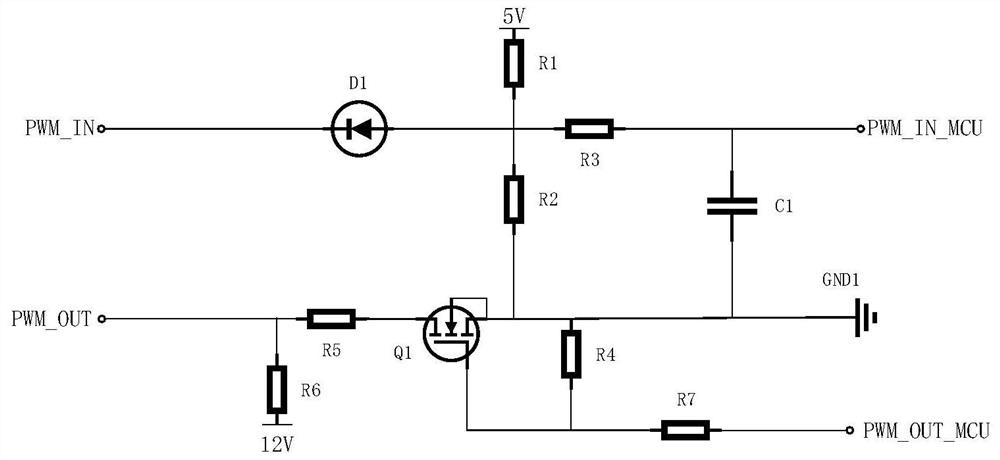A method for automatically assigning slave addresses in a battery management system
A battery management system and automatic allocation technology, applied in transmission systems, digital transmission systems, electrical components, etc., can solve the problems of error-prone, increased human workload, and low verification accuracy, achieving simple methods and improving address allocation. Efficiency and high calibration accuracy
- Summary
- Abstract
- Description
- Claims
- Application Information
AI Technical Summary
Problems solved by technology
Method used
Image
Examples
Embodiment 1
[0033] The battery management system of this embodiment is composed of 1 host and 3 slaves, and its slave address automatic allocation method includes the following steps:
[0034] 1) The host sends a 2% rising edge duty cycle waveform through the PWM_OUT interface;
[0035] 2) After the 1# slave receives the waveform through the PWM_IN interface, it detects that the duty cycle is 2%. At this time, the local machine ID is 0 through the table lookup, and the 4% duty cycle waveform is sent through the local PWM_OUT interface, and used Message 0x300 sends the received waveform and the duty ratio of the transmitted waveform to the host through the CAN bus;
[0036] 3) After the 2# slave receives the waveform through the PWM_IN interface, it detects that the duty cycle is 4%. At this time, the local ID is 2 through the table lookup, and the 6% duty cycle waveform is sent through the local PWM_OUT interface, and used Message 0x302 sends the received waveform and the duty ratio of t...
Embodiment 2
[0040] The battery management system of this embodiment is composed of 1 host and 4 slaves, and its slave address automatic allocation method includes the following steps:
[0041] 1) The host sends a 2% rising edge duty cycle waveform through the PWM_OUT interface;
[0042] 2) After the 1# slave receives the waveform through the PWM_IN interface, it detects that the duty cycle is 2%. At this time, the local machine ID is 0 through the table lookup, and the 6% duty cycle waveform is sent through the local PWM_OUT interface, and used Message 0x300 sends the received waveform and the duty ratio of the transmitted waveform to the host through the CAN bus;
[0043] 3) After the 2# slave receives the waveform through the PWM_IN interface, it detects that the duty cycle is 6%. At this time, the local machine ID is 2 through the table lookup, and the 10% duty cycle waveform is sent through the local PWM_OUT interface, and used Message 0x302 sends the received waveform and the duty r...
Embodiment 3
[0048] The battery management system of the present embodiment is made up of 1 master and 5 slaves, and its slave address automatic assignment method comprises the following steps:
[0049] 1) The host sends a 3% rising edge duty cycle waveform through the PWM_OUT interface;
[0050] 2) After the 1# slave receives the waveform through the PWM_IN interface, it detects that the duty cycle is 3%. At this time, the local ID is 0 through the table lookup, and the 6% duty cycle waveform is sent through the local PWM_OUT interface, and used Message 0x300 sends the received waveform and the duty ratio of the transmitted waveform to the host through the CAN bus;
[0051] 3) The 2# slave detects that the duty cycle is 6% after receiving the waveform through the PWM_IN interface. At this time, the local machine ID is 2 through the table lookup, and the 9% duty cycle waveform is sent through the local PWM_OUT interface, and used Message 0x302 sends the received waveform and the duty rati...
PUM
 Login to View More
Login to View More Abstract
Description
Claims
Application Information
 Login to View More
Login to View More - R&D
- Intellectual Property
- Life Sciences
- Materials
- Tech Scout
- Unparalleled Data Quality
- Higher Quality Content
- 60% Fewer Hallucinations
Browse by: Latest US Patents, China's latest patents, Technical Efficacy Thesaurus, Application Domain, Technology Topic, Popular Technical Reports.
© 2025 PatSnap. All rights reserved.Legal|Privacy policy|Modern Slavery Act Transparency Statement|Sitemap|About US| Contact US: help@patsnap.com


